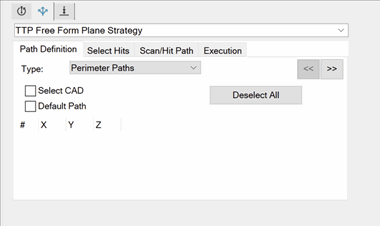
You can use the Path Definition tab for the TTP Free Form Plane strategy to generate a scan path/hit path.

Sample Path Definition tab
The scan/hit path methods appear in the Type list:
It is possible to use a combination of methods to generate a scan or hit path.
Points List Area
The points list area displays the points that you select on the CAD or take on the CMM manually (for the Teach Path and User Defined Path types only):
# - Displays a number or letter that identifies the point.
X, Y, Z - The XYZ values appear in this area.
Pt. Type - Indicates the type of point for the Teach Path method of generating the scan path.
>> - To set additional properties for the type you selected and generate the scan path, click this button.
<< - To return to the points list area, click this button.
To delete one or more points, right-click in the points list area. PC-DMIS displays the Remove and Clear options.
To delete one point, highlight it in the points list area, right-click, and select Remove. To delete all points, right-click in the points list area and select Clear; when the Remove all points? message appears, click OK.
To edit a point's X, Y, and Z values, double-click the point. The Edit Point dialog box appears. To navigate to and modify points, click >>.
For example:
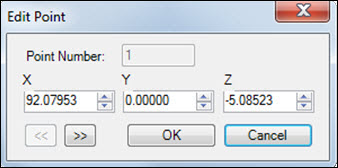
Sample Edit Point dialog box
This method generates the scan path along the perimeter of the surface. It requires CAD. This method of path generation is the default method when PC-DMIS is in DCC mode.
Generating a Default Perimeter Scan Path
You can generate a default perimeter scan path for a given plane. The start point of the default path is the edge closest to the point that you clicked to select the plane. The direction of the scan is counterclockwise in a given plane. The start and end points for the scan are the same. The default path generation uses the parameter set on the second screen that defines the path generation. When you select Create, the Scan/Hit Path tab displays the default path.
If you select the default path, you cannot modify any other parameters.
Selecting Multiple Surfaces of a Plane
A perimeter path supports planes that are separated. For example, the following is the front face on a demo block:

Example of front face on demo block
To select multiple surfaces of a plane, follow these steps:
Select the Select CAD check box.
If required, click Deselect All to deselect any selected surfaces.
Click on the first surface to select and highlight it.
Click on the second surface to select and highlight it.
If the first and second surfaces are separated, then PC-DMIS automatically selects the Default Path check box. The default path on each selected surface is generated.
Select any more surfaces by clicking on them.
PC-DMIS completes the Scan/Hit Path tab when you select Create.
Generating a Perimeter Path by Selection
You can generate a perimeter path when you select the start, direction, and end point on any one CAD surface. For a closed scan path, on any CAD surface, you can do this with just the start and direction point.
Do one of the following:
To define the start point, direction point, and end point, click on three points on the CAD. The points appear in the points list area. In the # column, 1 = start point, D = direction point, and 2 = end point. For example:

Sample perimeter path
To define the start point and direction point, click on two points on the CAD. The points appear in the points list area. In the # column, 1 = start point and D = direction point. When point 2 (the end point) is not defined, PC-DMIS uses point 1 to create a closed path.
To set perimeter controls, click >>. The Perimeter Controls area appears. Use the properties in this area to control perimeter point generation.
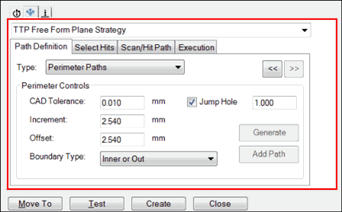
Sample Perimeter Controls area
CAD Tolerance - Type the tolerance that the point locating algorithm uses.
Increment - Type the minimum distance between adjacent points.
Offset - Type the offset distance from the boundaries.
Boundary Type - Select the boundary type on the selected surface that should be considered in the path calculation: Inner Only, Inner or Out, or Outer Only.
Jump Hole - If you select this check box, it generates a break point in the scan path whenever the scan path is over the holes in the CAD surface. Type the required distance from the edge in the box.
Generate - To generate the points and display them in the points list area, click this button. PC-DMIS shows the generated path on the CAD in the Graphic Display window. You can change the start point, direction point, and end point and then regenerate the scan path, if required.
Add Path - To add the points to the Scan/Hit Path tab, click this button. When the scan path is added, the hit points are also selected based on the selection criteria that is currently specified on the Select Hits tab.
This method generates the scan path along the path of the points defined. It requires CAD. To use this method to generate the scan path:
Click on the CAD to define the free form path. A minimum of five points must be recorded to calculate the scan path. The points appear in the points list area. For example:
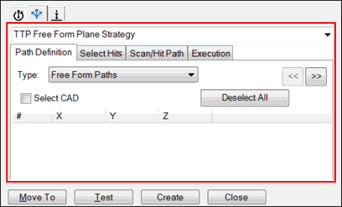
Sample free form path
To set free-form path controls, click >>. The FreeForm Controls area appears. Use the properties in this area to control free-form point generation:
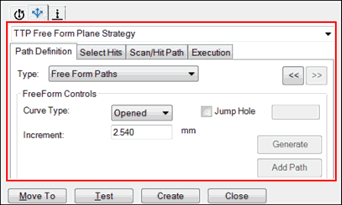
Sample FreeForm Controls area
Curve Type - Select the type of path to generate: open or closed.
Increment - Type the minimum distance between adjacent points.
Jump Hole - If you select this check box, it generates a break point in the scan path whenever the scan path is over the holes in the CAD surface. Type the required distance from the edge in the box.
Generate - To generate the points and display them in the points list area, click this button. The generated path is shown on the CAD in the Graphic Display window. You can change the points defining the free form path and then regenerate the scan path, if required.
Add Path - To add the points to the Scan/Hit Path tab, click this button. When the scan path is added, the hit points are also selected based on the selection criteria that is currently specified on the Select Hits tab.
You can teach or learn the scan path by taking hits on the CMM or CAD. The scan path is made of lines, arcs, and/or circles.
For help with generating a teach path, refer to the example of a detailed procedure in the "Sample Teach Path for TTP Free Form Plane Strategy" topic for scanning the top surface along a specific path.
To define the teach path, follow these steps:
Select the button for the type of path:
 Line
Line
 Arc
Arc
 Circle
Circle
For a line path, take one or two manual hits. For an arc path or a circle path, take two or three manual hits. The points appear in the points list area. For example:

Sample line path
The following apply to the points list area:
The Pt. Type column describes the type of point, such as: Line Start, Line End, Circle End, or Circle Midpoint<number>.
Any red points indicate that the path is incomplete and the points are not used to generate the path. If you change the path type (for example, from a line to an arc), the red points are removed.
If you edit the start point or the end point of a circle path, both points change because they are the same point.
To set teach controls, click >>. The Teach Controls area appears. Use the properties in this area to control point generation:
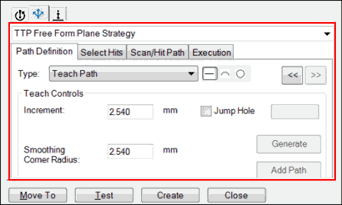
Sample Teach Controls area
Increment - Type the minimum distance between adjacent points.
Jump Hole - When selected, this check box generates a break point in the scan path whenever the scan path is over the holes in the CAD surface. Type the required distance from the edge in the box to the right of Jump Hole.
Smoothing Corner Radius - When PC-DMIS generates a scan path, the intersections have sharp corners. Smoothing the corner radius helps to smooth out the sharp corners. A circle with the center as the intersection point, and the radius that you enter in this box, is defined. All of the points in the scan path within this circle are smoothed out.
Generate - To generate the points and display them in the points list area, click this button. The generated path appears on the CAD in the Graphic Display window. You can change the points that define the teach path and then regenerate the scan path, if required.
Add Path - To add the points to the Scan/Hit Path tab, click this button. When the scan path is added, the hit points are also selected based on the selection criteria that is currently specified on the Select Hits tab.
This method teaches the hits that you want to take to measure a plane. To teach hits, you can use CAD or take hits on the machine. This method of path generation is the default method when PC-DMIS is in Manual mode. To use this method, click points at the desired locations on the CAD or take hits on the machine. The points appear in the points list area. For example:
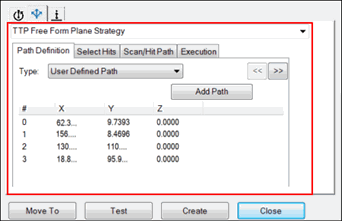
Sample User Defined Path
Add Path - To add the points to the Scan/Hit Path tab, click this button. PC-DMIS adds the points to the Scan/Hit Path tab and selects hit points as follows:
If no points were previously available in the points list area, PC-DMIS selects all of the points on the Scan/Hit Path tab as hit points. Note that the selection method on the Select Hits tab is set to Sector Hit Spacing with 0 as the spacing (all of the hit points in the scan path are selected).
If points were previously available in the points list area, PC-DMIS selects the hit points on the Scan/Hit Path tab according to the selection criteria that is currently specified on the Select Hits tab.
If necessary, you can add move points to the Scan/Hit Path tab.